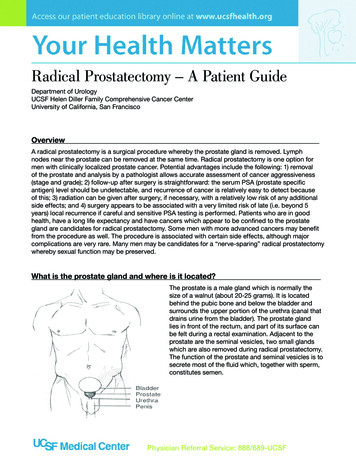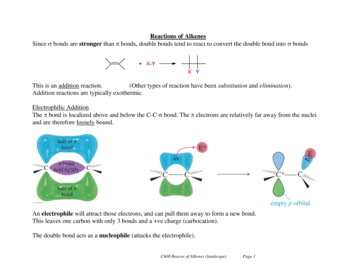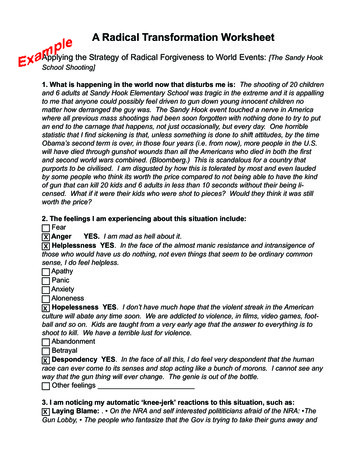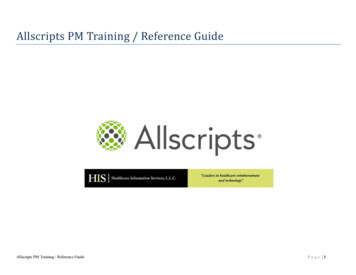
Transcription
Radical Prostatectomy – A Patient GuideDepartment of UrologyUCSF Helen Diller Family Comprehensive Cancer CenterUniversity of California, San FranciscoOverviewA radical prostatectomy is a surgical procedure whereby the prostate gland is removed. Lymphnodes near the prostate can be removed at the same time. Radical prostatectomy is one option formen with clinically localized prostate cancer. Potential advantages include the following: 1) removalof the prostate and analysis by a pathologist allows accurate assessment of cancer aggressiveness(stage and grade); 2) follow-up after surgery is straightforward: the serum PSA (prostate specificantigen) level should be undetectable, and recurrence of cancer is relatively easy to detect becauseof this; 3) radiation can be given after surgery, if necessary, with a relatively low risk of any additionalside effects; and 4) surgery appears to be associated with a very limited risk of late (i.e. beyond 5years) local recurrence if careful and sensitive PSA testing is performed. Patients who are in goodhealth, have a long life expectancy and have cancers which appear to be confined to the prostategland are candidates for radical prostatectomy. Some men with more advanced cancers may benefitfrom the procedure as well. The procedure is associated with certain side effects, although majorcomplications are very rare. Many men may be candidates for a “nerve-sparing” radical prostatectomywhereby sexual function may be preserved.What is the prostate gland and where is it located?The prostate is a male gland which is normally thesize of a walnut (about 20-25 grams). It is locatedbehind the pubic bone and below the bladder andsurrounds the upper portion of the urethra (canal thatdrains urine from the bladder). The prostate glandlies in front of the rectum, and part of its surface canbe felt during a rectal examination. Adjacent to theprostate are the seminal vesicles, two small glandswhich are also removed during radical prostatectomy.The function of the prostate and seminal vesicles is tosecrete most of the fluid which, together with sperm,constitutes semen.1
What is a radical prostatectomy?A radical prostatectomy is surgery to remove the entire prostate gland and seminal vesicles and, onoccasion, regional lymph nodes after a diagnosis of prostate cancer is made. Radical prostatectomyis one of many options for the treatment of prostate cancer. You should discuss all options with yourphysician.Radical prostatectomy can be done via an incision made in the abdomen (“radical retropubicprostatectomy”) or in the perineum, the area between the scrotum and the anus (“radicalperineal prostatectomy”). Alternatively, it may be done with laparoscopy (“laparoscopic radicalprostatectomy”). Laparoscopy is a technique in which surgery is performed by making small incisionsand passing specially designed telescopes and instruments into the body. Laparoscopic radicalprostatectomy is a relatively new technique, which may result in less discomfort and earlier returnto work. At UCSF we perform laparoscopic radical prostatectomies using a robotic surgical systemcalled the da Vinci robot. The system features magnification and surgical precision. Outcomesin terms of cancer control, urinary function and sexual function are generally similar to a radicalretropubic prostatectomy. The robotic approach has been modified based on our large experiencewith open surgery in order to optimize outcomes. The subtle differences between the procedurescan be discussed with your surgeon. At UCSF, the majority of procedures are done using a roboticapproach for the following reasons: the robotic approach appears to able to remove the prostatecancer equally as well as the open approach, it is associated with somewhat less blood loss andan earlier return to normal activities and may be associated with an enhanced ability to spare theneurovascular bundles. However, selected patients, usually those with more advanced cancers, maybenefit from the open approach.In addition to removing the prostate gland, the lymph nodes in the area of the prostate may beremoved either before or during the same operation. This is done to determine if the prostate cancerhas spread to the lymph nodes. This procedure is called "pelvic lymph node dissection." The riskof having cancer in the lymph node can be estimated and only men with a moderate or high risk ofpelvic lymph node metastases need to undergo pelvic lymph node dissection. Criteria for lymphnode dissection vary, but may include high grade (Gleason pattern 4 or 5), higher PSA values and/orpossible extra-prostatic disease based on preoperative ultrasound.Why would I choose to have a radical prostatectomy?Radical prostatectomy is one of several options for men whose prostate cancer still appears to belocalized to the prostate. It allows, in most cases, for complete removal of the cancer. Once theprostate is removed, one can tell how advanced the cancer is, what the risk for cancer recurrence isand whether or not additional treatment may be needed. It is relatively easy to follow men who haveundergone radical prostatectomy to be sure their cancer is gone. Once the prostate is removed, PSAshould fall to undetectable levels within six weeks. Radiation can be given after surgery, if necessary,with a relatively limited risk of any additional side effects.Patients who choose radical prostatectomy should be in very good health, have a life expectancyexceeding 10 years, have cancers that appear to be localized to the prostate gland and have discussedall available treatment options with their doctors. Some men with prostate cancer extending beyond theprostate gland may be candidates for the procedure as well. Radical prostatectomy may occasionallybe an option when prostate cancer recurs after radiation or other treatments. This approach ("salvageprostatectomy") carries higher risks of side effects, and should be considered carefully.2
What will happen before surgery?Before surgery, a number of tests will be performed to determine the extent of the disease. Thesetests include blood tests, transrectal ultrasound, and a prostate biopsy. In selected patients, abone scan and a CT or MRI scan of the abdomen and pelvis may be done. You will have a physicalexamination performed and discuss the various types of anesthesia with anesthesiologists. Thisvisit will be arranged by your doctor and will occur the week before surgery. You will be admittedto the hospital on the day of your surgery. However, you may begin a “bowel prep” at home on theday before your surgery. This is done to cleanse the bowel and may consist of a clear liquid diet,medication to promote bowel movements, and/or an enema. This is a routine preparation done beforemany types of abdominal and pelvic surgery.What type of anesthesia should I have and do I need to donate blood?There are various types of anesthesia. General anesthesia is a technique whereby theanesthesiologists give medication, which allows patients to be “asleep” or unconscious during theprocedure. Spinal or epidural anesthesia are techniques whereby medication is instilled into the spacearound the spinal cord. Epidural anesthesia allows for the delivery of medication postoperativelythrough a small tube or catheter in the back, resulting in continuous levels of pain medication. Thetechniques may be combined. Most UCSF radical prostatectomy patients do not require spinalor epidural anesthesia; we normally use general anesthesia with ketorolac, an anti-inflammatorymedication, after surgery. With the laparoscopic approach, general anesthesia is required.Donation of autologous blood (your own blood) is offered to patients, but given the limited blood lossnoted by most experienced surgeons, it may not be necessary. This limited blood loss tends to beeven less with laparoscopic (robotic-assisted) surgery. If you do wish to donate blood, 1 to 2 units ofblood can be stored and used at the time of surgery if it is necessary.What happens during surgery?Lymph node dissectionWhen prostate cancer spreads (metastasizes) itoften does so into lymph nodes in the area of theprostate. For this reason, the lymph nodes closeto the prostate may be removed to check fortumor spread. The lymph nodes may be removedduring either open or laparoscopic (robot-assisted)surgery and will be performed at the same timeas prostate removal using the same incision(s).As mentioned, lymph node dissection is notnecessary in all patients. Only those at moderateor high-risk of lymph node metastases needundergo the procedure.3
Radical prostatectomyAt the time of radical prostatectomy, the entire prostate gland and seminal vesicles are removed.The seminal vesicles are glandular structures lying next to the prostate which may be invaded byprostate cancer. Once the prostate gland and seminal vesicles are removed, the bladder is reattachedto the urethra. A catheter is left in the bladder to allow drainage of urine while healing takes place. Inaddition, a “drain” (tube that drains fluid accumulations) is left in place for one or two days.before surgeryafter surgeryNerve-sparing radical prostatectomyThe nerves and blood vessels (“neurovascularbundles”) which allow the penis to become erectrun on either side of the prostate. The figureshows a cross-sectional MRI of the prostatePROSTATEgland. The arrows note the neurovascularbundles. These bundles may be partially orGLANDcompletely spared during radical prostatectomy,thereby preserving sexual function in some men.Either one or both bundles can be spared. Thebest results are achieved if both bundles can bespared. Young men who are sexually active andRECTUMreport having very good erections are most likelyto benefit from preservation of the bundles.Figure Cross-sectional MRI Image of the Prostate ShowingOlder men and men who report limited erectionsthe Position of the Neurovascular Bundles (arrows).are less likely to benefit. In some cases,preservation of the bundle may not be advised due to the location or extent of the cancer. As thenerves run very close to the prostate, preservation of the bundles in some men may risk leavingcancer behind. The risks and benefits of nerve-sparing surgery should be discussed with your doctor.Whereas urinary continence tends to return early after surgery, sexual function returns more graduallyin those who have undergone nerve-sparing radical prostatectomy. Little or no function is notedimmediately after surgery in most men. Erections show more substantive improvement in the first sixmonths, and may continue to improve up to 18 to 24 months after surgery. Return of erections maybe facilitated by early use of oral drugs (Viagra/Levitra/Cialis) or penile injection therapy. You shoulddiscuss these and other options with your doctor.Please see the Your Health Matters document Managing Impotence – A Patient Guide for moreinformation (http://urology.ucsf.edu/patientGuides/pdf/Manage Impotence.pdf).4
What should I expect after surgery?Eating and drinkingYou will begin to drink fluids shortly after the procedure and will be allowed to eat solid food thereafter.Duration of hospitalizationThe three goals which must be met in most cases before you may return home after surgery are: Pain control with oral medications Tolerating solid food Walking unassistedAfter either open or laparoscopic prostatectomy most men are well enough to go home the next dayafter surgery. Some will stay a second day, especially if the surgery finished later in the day.Drains and dressingsAll abdominal incisions are usually closed with absorbable suture, so no sutures or clips need to beremoved. The incisions are covered with bandages called Steri-strips which help keep them closedwhile the skin heals. These usually fall off in the shower in one to two weeks, and can be removed if notgone by two weeks. Covering the Steri-strips will be gauze dressings with paper or clear plastic tape;these can be removed 48 hours after surgery. Laparoscopic incisions may be dressed with a bioglueor band-aids instead of traditional bandages. The glue will gradually wear away, within a week or two.Managing painBoth open and laparoscopic (robot-assisted) prostatectomies are generally tolerated with relatively littlepain. After surgery you will receive an anti-inflammatory medication called ketorolac (Toradol), whichis similar to ibuprofen (Motrin), unless you have a history of stomach ulcers or kidney dysfunction. Forsome men, this is sufficient. If you do have pain, you may receive oral narcotic tablets, usually Vicodin(hydrocodone and acetominophen), and if your pain is more severe you can receive intravenoushydromorphone (Dilaudid), which is similar to morphine. Narcotics, both oral and intravenous, can causenausea and drowsiness and tend to slow bowel function, so you should use only as much of thesemedications as you need. On the other hand, it is important to make sure your pain is controlled enoughnot just to lay in bed, but also to take deep breaths, cough and walk. It is easier to stay ahead ofpostoperative pain than to try to catch up once in severe pain, so make sure you ask for pain medicineearly if needed. The same guidelines apply when you go home with medication (usually Vicodin) forpain. If you feel you are not getting adequate pain relief, please feel free to discuss this with your nurseor doctor. Each person’s experience of pain is different, and although we may not be able to completelyeliminate all of your discomfort, we want you to be as comfortable as possible after your surgery.BathingYour nurse will assist you with a daily sponge or bed bath. Showers are permitted after the dressingshave been removed, usually within two or three days. Do not take a bath, swim, or otherwise soak theincisions for four weeks to avoid having the sutures absorb more quickly than they should.5
What you can do to helpTo prevent complications, such as pneumonia and blood clots, you will be encouraged to do threethings as soon as possible after surgery: walk, use your incentive spirometer (a small disposabledevice which encourages deep breathing) and do your leg exercises. The nurses will instruct you onhow to use the spirometer and do leg exercises, and will assist you in walking after surgery until youcan manage on your own. While in bed you will have compression devices on your legs which squeezeintermittently to prevent blood clots. You can remove them only once you are walking regularly.Going home: what to expectDiet and exerciseIt is normal to feel tired for several weeks after your surgery. Make sure someone drives you homefrom the hospital. Get plenty of rest, eat a well-balanced diet with plenty of protein and iron, and dosome light exercise (such as walking) every day. You should drink at least two to three liters of fluidseach day, and monitor the color of the urine in the catheter tubing (not the bag). The urine should beclear or light yellow. If the color is dark yellow or light red you should drink more fluids. Do not do anyheavy lifting (more than 10 to 20 pounds) or strenuous exercise for two to four weeks following surgery.You can increase your exercise schedule gradually thereafter. Light exercise such as walking, joggingand stretching should be done initially. Golf or tennis can be played within two to three weeks. If youfeel comfortable, you can increase your activity. Heavy abdominal exercise, such as sit-ups as well ascycling on an upright bicycle, should be avoided for six weeks. It is important that you do exercise thatyou feel comfortable with. Any activity that causes pain should be avoided.DrivingDriving is usually permitted after the catheter is removed if you feel comfortable, are taking no narcoticpain medication and can twist your torso quickly to look over your shoulder without significant pain.Caring for the incisionThe incision for an open prostatectomy runs from above the base of the pubic area to well belowthe navel. The key words here are “clean” and “dry,” showering once a day should do it. If you noticeextreme or increasing tenderness, progressive swelling, more than a small amount of drainage (i.e.teaspoon) or any pus or redness, notify your doctor right away. Incisions from laparoscopic radicalprostatectomy are smaller, but more numerous. They should be cared for similarly.Going home with a catheterYou will be discharged from the hospital with a catheter in place to drain urine from the bladder into abag. The balloon port of the catheter should be secured to the leg with a Stat-lock at all times. Shouldthe catheter fall out or malfunction you should call your urologist and not allow an emergencydepartment or other non-urology physician to replace or manipulate the catheter. A large bagshould be used at night and while at home to allow for better drainage. The leg bag should be usedwhen out and about. The doctor will remove the catheter in the office in five to 14 days.Be sure to clean the catheter where it exits your penis twice a day with soap and water, to apply asmall amount of water-based lubricant (Surgilube, KY, etc.) to the catheter at the tip of penis (meatus)to minimize irritation, and to empty the bag frequently. The bag should always be positioned lower thanyour bladder (i.e. secured to your leg or on the floor at the side of the bed). A small amount of rednessat the tip of the penis and/or discharge around the catheter is usually a sign of mucosal irritation, notpus, and is a sign that the catheter should be cleaned and/or lubricated more often. On occasion, thecatheter may irritate the bladder, causing “bladder spasms” which can be quite uncomfortable. Most6
patients will be sent home with bladder spasm medication. Pain behind the pubic bone or the tip of thepenis as well as leakage around the catheter may be signs of bladder spasm. If these occur, you shoulduse the prescribed medication. Leakage of urine around where the catheter exits the penis may alsooccur, if most of the urine is still draining into the bag this can be managed by wearing incontinencepads as described in the next section. However, if the urine is leaking and little or none is draining intothe bag you should call your doctor. It is normal for your urine to look cloudy for a few weeks aftersurgery. Occasionally, bleeding may occur around the catheter or be noticed within the urine. This isalso common. If passage of large clots, more than an inch in length, is noted or if the catheter becomesplugged, contact your physician. No anesthesia is required for catheter removal and only a littlediscomfort is experienced by most patients.Managing incontinenceAfter your bladder catheter is removed, you may have leakage of urine (“incontinence”). Initially, theleakage may be significant (leakage all the time). Your doctor or nurse will teach you exercises whichyou can do to strengthen your sphincter muscle. These are called Kegel exercises and they can bedone anytime: when lying down, sitting, standing or walking. You should do 200 repetitions of fivesecond Kegel exercises per day. These exercises will tend to decrease the amount of time it takes youto recover continence.At your local pharmacy you can buy incontinence pads such as “Attend” or “Depend” to protect yourclothing and waterproof underpads to protect bedding. These can be obtained without a prescriptionand are available in a variety of sizes and absorbencies. Please bring one or two pads to your physician’soffice the day your catheter is to be removed. Your ability to maintain bladder control should improvesignificantly with time. Normally, continence returns in three phases: Phase I – you are dry when lyingdown; Phase II – you are dry when walking; Phase III – you are dry when you rise from a seatedposition, cough or exercise. Most patients regain very good control by three months. However, it maytake more time for some patients. If adequate urinary control does not return by six months, consultyour doctor. If you believe that the force or diameter of your urinary stream is slow or narrow, or if youhave any difficulty or pain on urinating, notify your doctor immediately. Rarely, scarring may causeblockage to the normal flow of urine. Most often, this can be treated easily by dilating the urethra. Thisis a brief procedure which can be done with local anesthesia in an outpatient setting.Skin careIf you have any incontinence, your skin may become irritated (depending on the amount of urinaryleakage). You may need to protect your skin with a barrier such as Desitin or A&D ointment. If youdevelop a rash, notify your doctor.Managing constipationConstipation is a common side effect of pain and bladder spasm medications. During the time thatyou are taking them, be sure to increase your fluid intake (at least eight glasses of water a day), takestool softeners, and eat lots of roughage (whole grains, fruit and vegetables). Use laxatives only as alast resort. Diarrhea may also occur in the first few days after surgery as your bowel function returns tonormal. This usually fairly mild; if it is severe or not improving, contact your doctor.MedicationsYou will go home with the following medications:1. A n anti-inflammatory medication (e.g., ibuprofen or naproxen) which reduces both pain andinflammation. You should take this for at least a few days after you go home, or until you arefree of significant pain. These should be taken with a full glass of water and ideally with food.7
2. A narcotic pain medication (e.g., Vicodin/hyrdrocodone or Percocet/oxycodone), which youshould take, one to two tablets every six hours as needed. These can cause nausea andconstipation.3. A medication for bladder spasm (e.g., Ditropan/oxybutynin), which you can take up to everyeight hours as needed. This can also cause constipation and drowsiness, as well as drymouth. Do not take Ditropan starting 24 hours before your catheter is due to be removed.4. A stool-softener (Colace/docusate) which should be taken as long as you are taking narcoticpain or bladder spasm medication, unless you develop diarrhea.5. A medication for erectile restoration (Viagra, Levitra or Cialis). These medications work byincreasing the flow of fresh blood to the penis, which in turn may facilitate nerve recovery. Youshould take a half a pill before bed two to three times a week starting immediately after surgeryor after the catheter is removed. You should not expect to have erections, although they mayoccur. Taking these pills early after surgery is meant to improve the likelihood that you will havegood recovery of function later.6. D epending on your age and other medical problems, you may be given a beta-blocker (e.g.,metoprolol) to protect your heart, which you should continue for seven days after surgery.7. I f you take aspirin or anti-platelet agents such as Plavix, these can be resumed seven daysafter surgery unless your physician informs you otherwise.8. I f you take Coumadin (warfarin) talk with your doctor about the timing of resuming this pill.What about sex?Some men find it difficult to have an erection after radical prostatectomy. The nerves and bloodvessels (neurovascular bundles) that control erection are located on either side of the prostate.Sometimes one or both of these nerves and vessels can be preserved during surgery (“nerve-sparing”radical prostatectomy), thereby maintaining the ability to have an erection. However, depending onyour age, your pre-operative ability to obtain and maintain an erection, and the extent of the cancer,natural erections may not return. In some cases, the neurovascular bundles need to be removedbecause cancer may extend close to them. Therefore, complete cancer excision may not be possiblewithout removing them. Please feel free to discuss any concerns with your physician, who will provideinformation about alternative ways to manage impotence, such as oral drugs (Viagra/Levitra/Cialis),penile injections, vacuum pumps, and, rarely, penile implants. Since the prostate has been removed,there will be no ejaculate (semen) released. Whether or not you are able to obtain an erection, youshould still be able to have an orgasm (climax) with stimulation to the penis. A UCSF Your HealthMatters guide titled "Managing Impotence - A Patient Guide" is available in the Urologic Oncology Clinic,at the Cancer Resource Center, and on-line at ml.In addition an excellent booklet entitled “Sexuality & Cancer: For the Man Who Has Cancer, and HisPartner” is available from the American Cancer Society free of charge. Please call your local chapterfor a copy. It is important to realize that one can continue to be sexually active despite even extensiveprostate cancer treatment. Be open-minded, seek treatment for impotence if it occurs and realize thatsexual gratification can be achieved (for you and your partner) in many ways.Is there anything else I should know?Swelling and bruising of the penis and scrotum occur commonly after radical prostatectomy. This istemporary and should resolve within four to seven days. Swelling of the feet or legs is uncommon andyour doctor should be notified if this occurs.8
What is the pathology report and how do I interpret it?Once the prostate gland and lymph nodes are removed, a pathologist will coat the prostate with inkand fix all the tissues in substances which will preserve the architecture of the tissues and allow thepathologist to detect the extent of the cancer using the microscope. The prostate gland is coated withink to allow the pathologists to determine how close any cancer comes to the edge of the prostate.There are at least three features which are important in the pathology report: cancer grade, cancerstage, and margin status.Cancer gradeCancer grade refers to how malignant cancer cells look through the microscope. Most often gradesare assessed using the Gleason grading system named after the pathologist who developed it.Gleason grade is a numerical value given to prostate cancers that measures tumor grade. Gradesare assigned to the most common pattern of cancer as well as the second most common. Gradesfor each pattern range from 1 to 5. A grade of 1 denotes a cancer that closely resembles benign ornormal tissue. A grade of 5 is assigned to cancers that appear aggressive and differ significantly frombenign tissue. Therefore two grades are given: a primary and secondary grade. When added together,a total sum or Gleason sum is obtained. This sum can range from 2 to 10 but in contemporary practiceis rarely below 6 (see below).Cancers with both primary and secondary grades of 1 to 3 (sums of 2 to 6) tend to have a betteroutcome (lower chance of recurrence), compared to cancers of higher grades. Cancers with grades of4 and 5 (sum of 7 to 10), tend to have a higher chance of recurrence. A word of caution about Gleasonsum 7 cancers (3 4 or 4 3): Gleason grade 3 4 cancers are associated with a lower risk of recurrencecompared to grade 4 3 cancers. Over the years pathology grading practices have changed so thatGleason grades 1 and 2 have become very uncommon. Today Gleason grade 3 is usually the lowestgrade assigned, and a Gleason 3 3 (Gleason sum 6) is the most common low-grade tumor.Cancer stageCancer stage is a measure that defines the extent of a tumor. T2 cancers are those completelyconfined to the prostate. T3 cancers are those that have gone beyond the prostate, either through thecapsule of the prostate, T3a, or into the seminal vesicles, T3b. T4 cancers are very rare and includethose which have invaded nearby organs such as the bladder. Patients with T3 cancers are at anincreased risk of cancer recurrence compared to those with T2 cancers.MarginsIt is the goal of surgery to remove all the cancer. A positive margin means that the pathologist noticesthat cancer cells are at the very edge of the prostate touching the ink that was applied during initialprocessing of the prostate gland. The pathologist will note the number and location of any positivemargins. Those patients with positive surgical margins are at an increased risk of cancer recurrence.Patients with more than one positive margin are more likely to have the cancer recur compared to thosewith a single positive margin. Patients with an extensive positive margin (large area where the canceris in contact with the edge of the prostate) are more likely to have recurrence of their cancer comparedto those with a very small area (focal positive margins) where the cancer just touches the edge.It is important to note that most patients with positive margins are cured by prostatectomy alone anddo not require further treatment. Depending on the number and extent of margins, your physician mayrecommend post-operative radiation to decrease the risk of recurrence.9
Do I need any additional treatment?Usually, you will not need any additional treatment after a radical prostatectomy. You and yourphysician will make a decision on the need for additional treatment based on the pathology report andyour PSA level after surgery. Your PSA should drop to undetectable levels after surgery. Patients withcancer in the lymph nodes, T3 cancers, high-grade cancers and positive margins are at an increasedrisk of recurrence and should discuss the type and timing of any additional treatment with their doctors.On occasion, radiation, hormonal therapy or any one of a number of new agents being evaluated inclinical trials may be given if the cancer removed was extensive or recurs in the future. All patientsshould have regular check-ups including PSA blood tests, and in very selected cases, imaging tests(bone scan, CT scan, MRI, etc.).How often do I need to see my doctor?You will see your doctor initially to be sure that your recovery and return of urinary continence isoccurring normally. For those who are sexually active and have not regained potency, your doctor willdiscuss various options for management. The frequency of docto
2 What is a radical prostatectomy? A radical prostatectomy is surgery to remove the entire prostate gland and seminal vesicles and, on occasion, regional lymph nodes after a diagnosis of prostate cancer is made.

![Radical Healing Syllabus[4] - School of Social Work](/img/36/radical-healing-syllabus-2.jpg)








